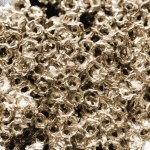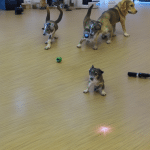Playing with your pets is a wonderful way to bond, exercise, and stimulate their mind. Interactive play can even help correct problematic behaviors. When it comes to playtime, toys are invaluable – and one toy that’s gained popularity over the years is the laser pointer. But is this light-emitting toy safe for all pets? Cats, dogs, and other feline and canine friends love chasing the elusive dot, but how should you use this toy to ensure your pet’s safety and enjoyment? Let’s delve into the exciting world of laser pointer play and discover the dos and don’ts for a fun, safe playtime experience.
Understanding and Respecting Your Pet’s Natural Behaviors
Before you can effectively play with your pet, it’s important to understand their natural behaviors. Cats, for example, are natural predators. They love to hunt, chase, and pounce, and toys that stimulate these behaviors can be a huge hit. Dogs, while they can also enjoy a good chase, might be more inclined to fetch games.
A lire aussi : What Are the Best Tips for Organizing a Pet-Friendly Community Event?
Laser pointers can tap into these behaviors, providing a prey your pets can chase, though never quite catch. The unpredictable movements of the laser dot can mimic the erratic movements of a small prey animal, making the game incredibly engaging for your pet.
However, not all pets respond to laser pointers in the same way. Some might become frustrated or obsessed with the uncatchable light. Others might simply lose interest. This is why observing your pet’s reactions and understanding their personal play style is crucial.
A voir aussi : How to Train Your Pet to Respond to Emergency Situations for Safety?
The Safe Use of Laser Pointers with Cats
A chase with a laser pointer can be a highly entertaining game for your cat. The fast-moving light can activate their hunting instincts, providing them with mental stimulation and physical exercise.
However, safety is paramount. Laser pointers can potentially cause harm if not used properly. Never shine the laser directly into your cat’s eyes as this can cause damage. Always aim the light at a surface – a wall, floor, or piece of furniture.
Another safety concern is that your cat may accidentally harm themselves while chasing the laser. Ensure play areas are free of hazards that your cat could run into or knock over.
Also, remember that because your cat can never ‘catch’ the laser dot, this can lead to frustration. Balance laser play with toys that your cat can physically catch and ‘kill’. This can help satisfy their hunting instincts and prevent them from becoming frustrated or obsessed with the laser.
Guidelines for Playing with Dogs and Laser Pointers
Dogs, like cats, can enjoy a good chase. However, laser pointer play is not suitable for all dogs. Some dogs might become overly excited or obsessed with the light, leading to problematic behaviors.
If you decide to try laser play with your dog, follow similar safety guidelines as with cats. Never shine the light directly into your dog’s eyes and ensure the play area is safe.
However, be extra vigilant for signs of obsession or frustration in dogs. If your dog starts to constantly search for the light, even when not playing, it might be best to stop using the laser pointer. Instead, opt for more tangible toys that your dog can fetch and return, satisfying their instinct to retrieve.
The Role of Laser Pointers in Pet Training
While laser pointers can offer a great source of exercise and fun, they can also be useful in training your pets. The key is to use the laser pointer as a tool for positive reinforcement, not as a means to tease or frustrate your pet.
For both cats and dogs, the laser can be used to guide them through certain behaviors or tricks. For example, you can use the light to guide your cat to jump onto a certain spot or guide your dog to a certain area of the room.
Remember, always pair the use of the laser pointer with positive reinforcement such as treats, praise, or a favorite toy. This way, your pet associates the laser pointer with positive experiences and learns to see it as part of a rewarding game rather than a source of frustration.
Laser Pointer Alternatives for Interactive Play
If you find that your pet is not responding well to the laser pointer, don’t worry. There are plenty of alternative interactive toys that can offer the same level of exercise and mental stimulation.
For cats, consider toys that mimic the movement and sound of prey, such as electronic mice or feather wands. Interactive puzzle toys can also be a great way to challenge your cat’s mind and satisfy their hunting instincts.
For dogs, consider toys like balls, discs, or tug toys. Interactive toys that dispense treats can also be a great way to keep your dog engaged and reward them for their play.
And remember, no toy can replace the value of spending quality time interacting with your pet. Whether it’s a game of fetch, a training session, or simply a snuggle on the couch, nothing can replace the bond between you and your pet.
The Psychological Impact of Laser Pointers on Pets
It’s essential to understand the psychological impact of laser pointers on pets. While providing an outlet for their natural instincts, laser pointers can also potentially lead to frustration and obsession due to their elusive nature. This is particularly true if the laser pointer is the only form of play your pet is exposed to.
Cats and dogs are wired to enjoy the thrill of the chase, but they also love the satisfaction of catching their prey. With a laser pointer, however, they can never actually catch the red dot. This can lead to confusion, frustration, and even obsession. In some cases, pets may begin to chase any light reflections or shadows they see, even when the laser pointer is not in use.
To prevent this from happening, it’s important to diversify your pet’s playtime activities. Don’t rely solely on the laser pointer for play. Instead, mix it up with other toys and activities that allow your pet to ‘catch’ their prey. For example, use stuffed animals, balls, or squeaky toys that your pet can physically catch and interact with. This allows them to feel the satisfaction of a successful hunt, reducing potential frustration or obsession.
Conclusion: Ensuring Safe and Enjoyable Laser Play
In conclusion, laser pointers can be highly engaging toys for pets when used correctly. The key to safe and enjoyable laser play lies in understanding your pet’s natural behaviors, observing their reactions to the toy, and following safety guidelines.
Never shine the laser directly into your pet’s eyes, and always ensure play areas are free of hazards. Monitor your pet for signs of frustration or obsession, and remember to balance laser play with other forms of interactive play that cater to your pet’s instinct to ‘catch’ their prey.
If your pet doesn’t respond well to the laser pointer, there are plenty of other interactive toys that can provide mental stimulation and physical exercise. The most important thing is that your pet enjoys their playtime and that it brings you closer together.
Finally, although laser pointers can be a source of fun and exercise for your pet, they should never replace quality time spent together. Playing with your pet, training them, or even just snuggling on the couch is essential for their overall wellbeing and your mutual bond. So, while you enjoy the high-speed chases and hilarious antics that come with laser pointer play, remember to also spend time enjoying the simple, loving moments with your pet.











